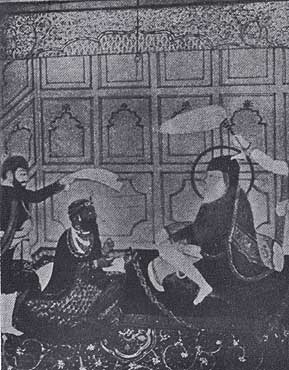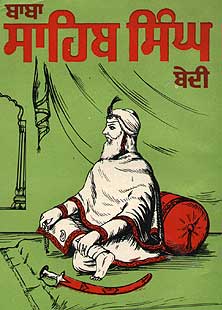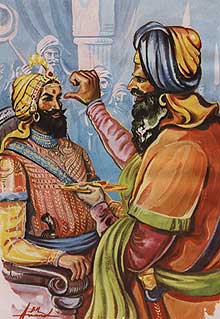
SAHIB SINGH BEDI, BABA (above)(1756-1834), tenth in direct descent from Guru Nanak, was much revered in Sikh times for his piety as well as for his martial prowess. He was born at Dera Baba Nanak, Gurdaspur district on chet sudi 5,1813 Bk/5 April 1756. Around 1770, his parents Baba Ajit Singh and Mata Sarupah Devi, shifted from Dera Baba Nanak to Una, a town now in Himachal Pradesh in the Sivalik foothills, where the family held extensive jagirs. As a young boy, Sahib Singh studied the Sikh sacred texts and had training in the use of arms. On the death of his father in Calcutta in 1773, Sahib Singh succeeded to the ancestral estate. He became widely reputed for his religious learning and devotees flocked to his magnificently-built fortress at Una to listen to his discourses. A charisma grew around his person and it was considered a signal honour to receive pahul or the Sikh initiatory rite at his hands. At the same time, he became the arbiter of political feuds among the misldars, then engaged in occupying territories in parts of the Punjab. The sardars settled upon him grants of lands and he came to acquire great influence in the Jalandhar Doab and the Majha region.

In
1794, he led a punitive campaign against the Afghan ruler, Ata Ullah Khan, of
Malerkotla. Tara Singh Ghaiba, Baghel Singh and Bhanga Singh of Thanesar joined
forces with him in this expedition. But Patiala, Nabha, Jind and Kalsia troops
intervened on behalf of 'Ata Ullah Khan and Sahib Singh withdrew after receiving
a war indemnity. In 1798, helped by the forces of Tara Singh, Gurdit Singh and
Jodh Singh, he attacked Rai lliyas, of Raikot, about 40 km from Ludhiana. He occupied
Jagraon, Dakha and Baddoval, and then advanced towards Ludhiana and Mansuran and
took both these places. A gurdwara in the village of Akhara (Ludhiana district)
commemorates his victory. During Shah Zaman's invasion of northern India (1796-98),
Sahib Singh spearheaded Sikh resistance. When on 7July 1799, the young Sukkarchakkia
chief Ranjit Sihgh took possession of Lahore, Sahib Singh threw his weight on
his side and helped him to vanquish Gulab Sihgh Bhangi in the battle of Bhasin
in March 1800.
At the time of Ranjit Singh's coronation
at Lahore on 11 April 1801, Baba Sahib Singh placed the tilak or mark of sovereignty
on his forehead. (Below)

In 1807, he helped to settle a longstanding dispute between the rulers of Nabha and Patiala. He was also instrumental in arranging a meeting between Sahib Singh of Patiala and Maharaja Ranjit Sihgh at Lakhnaur in November 1808, when they entered in to a bond of mutual fraternity by exchanging turbans. He accompanied Ranjit Sihgh on several of his military expeditions. Later in his life, Baba Sahib Singh devoted himself entirely to preaching Guru Nanak's word. He travelled extensively in the Pothohar, Majha and Malva regions and wherever he went people thronged in large numbers to see him and to pay homage to him. Baba Sahib Singh died at Una on 17 July 1834.
Excerpt taken with courtesy from 'Encyclopaedia of Sikhism', by Harbans Singh
